Book contents
- Frontmatter
- Contents
- Preface
- Acknowledgments
- Chapter 1 Introduction
- Chapter 2 Fibers and fiber products
- Chapter 3 Natural polymeric fibers
- Chapter 4 Synthetic polymeric fibers
- Chapter 5 Metallic fibers
- Chapter 6 Ceramic fibers
- Chapter 7 Glass fibers
- Chapter 8 Carbon fibers
- Chapter 9 Experimental determination of fiber properties
- Chapter 10 Statistical treatment of fiber strength
- References
- Suggested further reading
- Appendix A Some important units and conversion factors
- Author index
- Subject index
Chapter 2 - Fibers and fiber products
Published online by Cambridge University Press: 13 October 2009
- Frontmatter
- Contents
- Preface
- Acknowledgments
- Chapter 1 Introduction
- Chapter 2 Fibers and fiber products
- Chapter 3 Natural polymeric fibers
- Chapter 4 Synthetic polymeric fibers
- Chapter 5 Metallic fibers
- Chapter 6 Ceramic fibers
- Chapter 7 Glass fibers
- Chapter 8 Carbon fibers
- Chapter 9 Experimental determination of fiber properties
- Chapter 10 Statistical treatment of fiber strength
- References
- Suggested further reading
- Appendix A Some important units and conversion factors
- Author index
- Subject index
Summary
In this chapter, we define some important terms and parameters that are commonly used with fibers and fiber products such as yarns, fabrics, etc., and then describe some general features of fibers and their products. These definitions, parameters, and features serve to characterize a variety of fibers and products made from them, excluding items such as fiber reinforced composites. These definitions and features are generally independent of fiber type, i.e. polymeric, metallic, glass or ceramic fibers. They depend on the geometry rather than any material characteristics.
Fiber is the fundamental unit in making textile yarns and fabrics. Fibers can be naturally occurring or synthetic, i.e. man-made. There are many natural fibers, organic and inorganic. Examples include organic fibers such as silk, wool, cotton, jute, sisal and inorganic fibers such as asbestos and basalt. There is a large variety of synthetic fibers available commercially. Polymer fibers such as polypropylene, polyethylene, polyamides, polyethyleneterephthalate (PET), polyacrylonitrile (PAN), polytetrafluoroethylene (PTFE), aramid, etc. are wellestablished fibers. Metallic wires or filaments have been available for a long time. Examples include steel, aluminum, copper, tungsten, molybdenum, gold, silver, etc. Among ceramic and glass fibers, glass fiber for polymer reinforcement has been available since the 1940s; optical glass fiber for telecommunication purposes made its debut in the 1950s, while ceramic fibers such as carbon, silicon carbide, alumina, etc. became available from the 1960s onward.
- Type
- Chapter
- Information
- Fibrous Materials , pp. 8 - 36Publisher: Cambridge University PressPrint publication year: 1998



